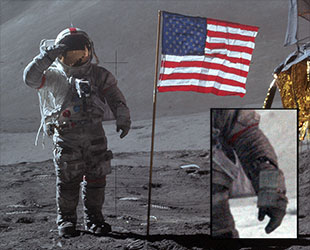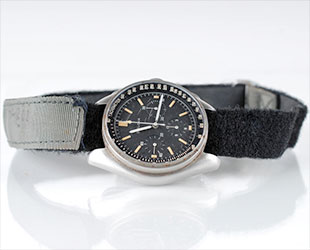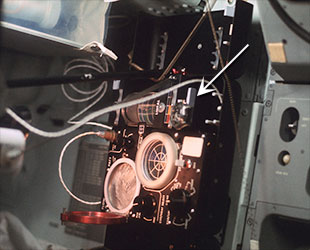October 23, 2015 — The only privately-owned watch to be worn on the surface of the moon was auctioned for more than $1 million on Thursday night (Oct. 22), setting what is believed to be a record for the most-ever paid for a piece of astronaut memorabilia.
The Bulova timepiece, which Apollo 15 commander David Scott wore during NASA's fourth successful lunar landing mission in 1971, was sold by RR Auction of Boston for an astronomical $1.625 million to a Florida businessman who wished to remain anonymous. The sale, which opened at $50,000 online on Oct. 15, ended Thursday evening during a live auction where the winner and his competing bidders participated by phone.
Scott, who also called in, listened as his very-well-traveled watch soared in a span of just five minutes from $475,000 to the hammer of $1.3 million (the $1.625 million includes the buyer's premium charged by the auction house).
According to RR Auction, the winner collects "unique, one-of-a-kind items," which is what attracted him to the watch.

Apollo 15 commander David Scott salutes the U.S. flag he helped plant on the moon in July 1971. On Scott's left arm is seen the only privately-owned watch worn on the lunar surface. (NASA/cS) |
In the 1960s, NASA issued Omega Speedmaster watches to the Apollo astronauts to wear on their missions. At the end of the program in 1973, the space agency transferred the chronographs to the Smithsonian, where most of them are still held today.
Scott wore the Omega on his first two moonwalks, during which he became the first person to drive a car, the lunar roving vehicle, on the moon. Sometime during his second outing though, the crystal that covered the Speedmaster's face popped off and was lost.
Fortunately for Scott, he had packed a Bulova wristwatch among his personal items, which he retrieved and wore for his third and final moonwalk. He then wore the alternate timepiece for the remainder of the Apollo 15 mission, up to and through his splashdown on Earth.
The watch, and the moondust-stained velcro strap that he used to hold both the Omega and Bulova chronographs to his spacesuited arm, then sat inside a safety deposit box for 40 years. In 1996, a quarter century after his Apollo 15 mission, Scott mistakenly told a researcher that the watch was made by Waltham, an error that he corrected when he went to retrieve the flown timepiece for the auction.

Scott auctioned his moon-worn Bulova chronograph together with the velcro strap he used on three moonwalks. (RR Auction) |
The sale's $1.625 million total tops the known prices paid for astronaut-owned artifacts. The previous record was for a cuff checklist used by Charles Conrad, the third man to walk on the moon, which reportedly sold for $1.3 million to a private buyer in 2001.
Even more has been paid for Soviet-era spacecraft.
At a 1993 Sotheby's auction, the Perot Foundation spent $1,652,500 for Russia's Soyuz TM-10 crewed capsule and then loaned the artifact to the Smithsonian's National Air and Space Museum in Washington, D.C., where it remains on display.
And in 2011, a Russian businessman paid $2,882,500 at Sotheby's to return the Vostok 3KA-2 capsule to his home country.
Collectors who missed out on buying the Apollo 15 Bulova watch will soon have another chance at owning a flown-to-the-moon timepiece. On Dec. 15, Christie's in New York is auctioning an Omega Speedmaster that flew on board the Apollo 17 mission in 1972.

The Omega Speedmaster that flew on Apollo 17as part of a heat flow experiment will be sold by Christie's. (NASA/collectSPACE) |
Unlike Scott and his Bulova though, astronaut Ron Evans did not wear the offered Omega while on the lunar surface, or at any time while he was in space. Instead, the watch was mounted to an experiment that orbited, but didn't land on the moon. Evans retained the watch after the mission as a memento, which a 2012 law confirmed as legal. (The NASA-issued Omega Evans wore is in the Smithsonian.)
Christie's hasn't published its estimate for what the Apollo 17 Speedmaster may sell for, but it was earlier auctioned for only $23,900 in 2009.
Article updated to correct 2009 sale price of Ron Evans' Apollo 17 Speedmaster. The earlier cited $11,950 was for his flown Speedmaster strap, rather than the Omega itself. Christie's is offering both the strap and watch as one lot in its December sale.
